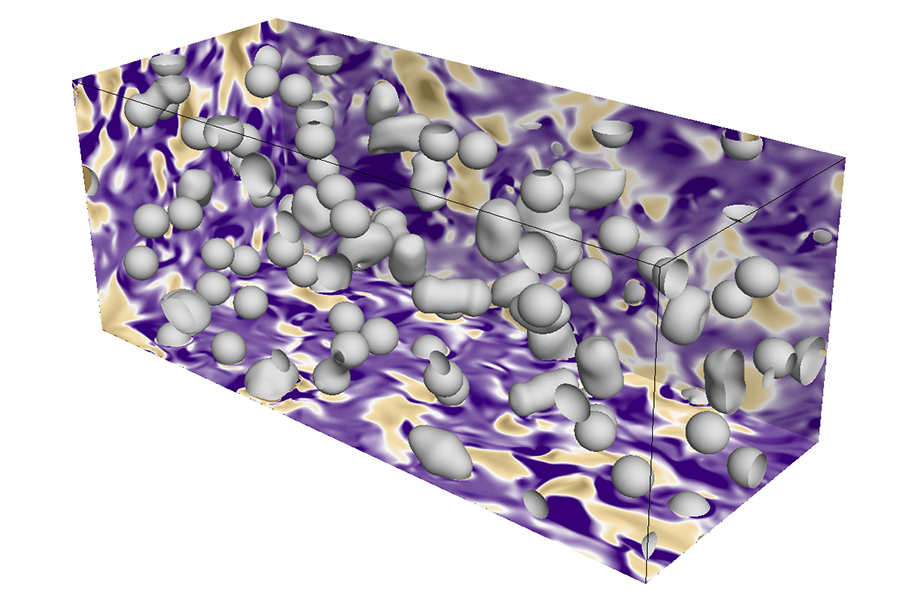Amy Sprague
March 11, 2024
A new droplet simulation method accelerates answers and uncovers new secrets in turbulent shear flows.

Microscopic visualization of a shear flow with Instantaneous droplet interfaces in gray, contours of turbulence kinetic energy production in purple and gold.
Tiny droplets that seemingly defy conventional flow laws have a big impact on aerospace applications. In a new paper, A&A Ph.D. student Pablo Trefftz Posada and Professor Antonino Ferrante reveal a significant breakthrough in developing a highly accelerated method for simulating and comprehending the behavior of droplets in turbulent shear flows.
What are turbulent shear flows?
Turbulent shear flows, characterized by significant velocity variations across the flow, result in chaotic and irregular movement of fluid particles. In these flows, the mixing and exchange of momentum among fluid particles create eddies and vortices, influencing mass, momentum, and energy within the flow. Such flows are prevalent in natural and industrial processes, including rain, rivers, atmospheric boundary layers, pipes, jets, liquid-liquid emulsions, spray cooling, and spray atomization in combustors.
“If we understand the complex dynamics of turbulent flows, we can improve the performance of aerospace systems. This understanding is crucial for designing efficient propulsion systems and optimizing aerodynamic performance of aircraft.”
Simulations reduced from months to two days

Antonino Ferrante
Traditionally, models to understand turbulent shear flow behavior took over two months to generate results. But now, Trefftz Posada and Ferrante have remarkably reduced the processing time by developing a new computational methodology to solve multiphase turbulent flows while leveraging supercomputing capabilities to run highly accurate simulations of droplets in turbulent shear flows. These simulations now provide a faster and more efficient means of understanding and predicting turbulent shear flows, crucial for modeling aerospace systems.
Trefftz Posada says, “For our new method, we ran eight simulations with different droplet properties by using 300 computing cores on the Stampede2 supercomputer, which was the flagship supercomputer of the Advanced Cyberinfrastructure Coordination Ecosystem: Services & Support (ACCESS). Each of these simulations took about two days to complete. Before our method was developed, each of these simulations used to take up to 75 days on such a supercomputer, and 62 years on a conventional personal computer!”
These simulations are highly accurate, but don't include any complex geometries. Engineers and scientists can use the results to improve their lower-accuracy models based on the accurate physics they have discovered.
A 2D slice of the full 3D domain for one of the eight simulations, showing color contours of local kinetic energy production. The droplet interfaces are shown by black lines.
The simulations uncover two previously-unknown mechanisms

Pablo Trefftz Posada
From the simulations, Trefftz Posada discovered two previously-unknown mechanisms to explain the physics of droplets in turbulent shear flows. Ferrante explains, “Pablo has unraveled the ‘catching-up’ and ‘shearing’ mechanisms that occur in the interaction of droplets with shear turbulence.”
The "catching-up" mechanism describes the phenomenon where droplets moving at different speeds due to the mean velocity eventually combine, leading to an increase in kinetic energy throughout the fluid when the surface tension is large enough to return the combined droplets to a more spherical shape. On the other hand, the "shearing" mechanism refers to the deformation of individual droplets due to the mean velocity, ultimately converting surface energy into turbulence kinetic energy.
As the aviation industry pushes for sustainable aviation fuel, accurate simulations will play a crucial role in designing engines that are as safe and efficient as possible.”
These discoveries hold significant implications for spray combustion and cloud physics, offering a deeper understanding of the interaction of droplets with shear turbulence. The results from these highly accurate simulations can be used to improve lower-accuracy models, enabling researchers to strike a balance between computational efficiency and accuracy, leading to informed decisions and the ability to tackle complex problems swiftly.
Trefftz Posada and Ferrante's accelerated simulations have not only revolutionized the understanding of droplet behavior in turbulent shear flows but also paved the way for enhanced aerospace applications, advancing the understanding of intricate dynamics of fluid behavior in challenging environments.
Trefftz Posada sums up the significance of the findings, “The two mechanisms we have discovered allow us to explain the pathways of turbulence kinetic energy in multiphase turbulent shear flows. Understanding these pathways helps engineers to perform more accurate simulations of the highly complex phenomena occurring inside jet engines. As the aviation industry pushes for sustainable aviation fuel, accurate simulations will play a crucial role in designing engines that are as safe and efficient as possible.”
Two droplets demonstrating the “catching-up” mechanism in a simplified configuration. All droplet properties match those in the video above. Droplet interfaces are black lines, velocity vectors are black arrows, color contours show local kinetic energy production, and total kinetic energy production is shown in the inset.
Go deeper
Investigating the Modulation of Turbulence Kinetic Energy in Droplet-Laden Homogenous Shear Turbulence investigates the modulation of turbulence kinetic energy (TKE) in droplet-laden homogeneous shear turbulence (DLHST). The authors conducted direct numerical simulations (DNS) to study the interaction between droplets and turbulence. They focused on droplets with a diameter approximately equal to twice the Taylor length scale of turbulence and examined the effects of shear number and Weber number on the modulation of TKE.